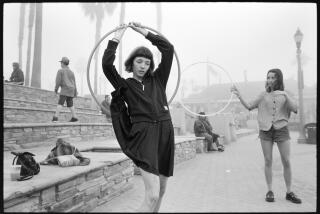Bruce Davidsonâs photos at Huntington show a Yankeeâs view of Britain
In 1960, photographer Bruce Davidson needed an escape route. He had just spent 11 months in Brooklyn shooting a teenage street gang for Esquire magazine, and now he found himself getting unwanted attention from grown-up gangsters who suspected Davidson was carrying wads of cash.
There were threatening phone calls. Davidson turned to his agency, the esteemed Magnum Photos, where Cornell Capa had an idea. âHe said, âIâll set you up in England, working for the Queen magazine,ââ Davidson recalls the older photographer suggesting. ââNothing could be safer.ââ
The young photographer traveled in a rented convertible, driving âaround until I found something,â ultimately capturing an ancient country adjusting to the late-20th century in vivid black-and-white. The result of that first trip to Britain (and others that followed) is on view through March 9 at the Huntington Library, Art Collections, and Botanical Gardens in San Marino.
A joint exhibition, âBruce Davidson/Paul Caponigro: Two American Photographers in Britain and Ireland,â collects the diverse work of two accomplished artists into a distinctly American view of the U.K., mingling Davidsonâs street-level portraits and reportage with Caponigroâs epic landscapes.
During that first trip, Davidson saw businessmen in bowler hats and itinerant young travelers on the streets of London. He photographed vestiges of royalty and scores of the middle classes and the down-and-out amid urban and rural settings. Later that decade, he returned to the British Isles to focus on other parts of the society there, including a traveling circus in Ireland and miners in Wales.
âItâs very close to my heart, particularly the â60 work,â said Davidson, now 81. âThere I was, just a kid with a camera, and I had an assignment from the Queen magazine. I didnât want any of their help, I told them â I just have to go off by myself.
âI was looking for something, which I sometimes found, sometimes I didnât,â he explained. âBut thatâs how all my work has been. I call it the outside and the inside.â
The show originated at the Yale Center for British Art in New Haven, Conn., this summer, curated by the Huntingtonâs Jennifer A. Watts and Yaleâs Scott Wilcox.
On a recent visit for the exhibitionâs opening, Davidson sat in the gallery wearing shades of khaki and olive, the traditional garb of a photographer comfortable working out in the field. He looked on the wall where pictures from the traveling circus are collected and said that one of the children photographed now runs the circus.
âThe circus is a family,â he said, noting that after a photograph is taken, the story continues. âThereâs still life on the bone.â
Nearby were several pictures from his series on Welsh miners, a project he says was inspired by earlier pictures by the groundbreaking Robert Frank. âI was just drawn not only to those photographs but to the life,â he says. He traveled to Northern Wales in 1965 with a local poet, Horace Jones, who had been a miner earlier in life. âIt was a time when the mines were closing â what we would call punch mines and pit ponies, all that was going to go.â
Davidson is shooting a series of photographs of dioramas at the American Museum of Natural History in New York, where he might shoot with his lens pressed against the glass or step back and watch visitors interact with the scenes of wildlife frozen in time.
âI work out of a state of mind. I donât work because I read something in the New York Times or Vanity Fair. I have to feel that itâs right to do this now,â he says. âThere is something about those dead animals that make me come to life. Theyâre amazing. I think about an eagle, and looking at the feathers â you donât get a chance to do that, even if youâre a member of the Audubon Society.â
Davidson also reunited with Bobby Powers, the teen gang leader he first photographed in 1959, after his subjectâs long life as drug dealer, user and, finally, drug counselor at age 71.
Davidson and his wife, Emily Haas Davidson, collaborated on âBobbyâs Book,â recalling decades of Powersâ life. One day while piecing the collection together, Powers was talking about his mother while Davidson poured over old proof sheets. One image heâd never noticed before of a woman crossing the street while smoking a cigarette suddenly caught Davidsonâs attention.
âHe was very close to his mother. His mother was a drunk, and she fed seven kids. They used to eat oatmeal three times a day,â says Davidson. He showed Powers the image. âHe said, âYeah, thatâs my mother.â The life of a photograph goes on. They stay there a long, long time.â
------------
âBruce Davidson/Paul Caponigro: Two American Photographers in Britain and Irelandâ
Where: Huntington Library, Art Collections and Botanical Gardens, 1151 Oxford Road, San Marino
When: Through March 9
Info: (626) 405-2100, www.huntington.org
More to Read
The biggest entertainment stories
Get our big stories about Hollywood, film, television, music, arts, culture and more right in your inbox as soon as they publish.
You may occasionally receive promotional content from the Los Angeles Times.











